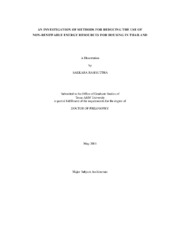| dc.description.abstract | The purpose of this research is to develop methods that reduce energy consumption in a
residential building in a hot and humid climate region (Thailand) using efficient architectural
building components and renewable energy (solar energy) to produce electricity, domestic hot
water, and supplemental cooling by night sky radiation.
Improving the architectural building components, including building materials, is an option
to reduce energy consumption in a building. Using renewable energy sources is another option to
reduce the consumption of non-renewable energy. In residential buildings, solar energy has been
utilized for space heating and domestic hot water using active solar collector systems and for
generating electricity using photovoltaic (PV) systems. One photovoltaic system, the hybrid
photovoltaic-thermal (PV-T) collector system, has been developed by several researchers over the
last 20 years. The hybrid photovoltaic-thermal (PV-T) collector system is a combination
photovoltaic (for producing electricity) and solar thermal collector (for producing hot water).
Theoretical and experimental studies of this collector have highlighted the advantages of the hybrid
PV-T collector system over separate systems of PV and solar collector in term of system efficiency
and economics. Unfortunately, very little experimental data exists that demonstrates the
advantages of a combined system. Therefore, one of the objectives of this study conducted was an
experimental study of this system as an auxiliary energy source for a residential building.
Night sky radiation has also been studied as a cooling strategy. However, no attempt so far
could be found to integrate it to a hybrid PV-T collector system. The night sky radiation strategy
could be operated with the hybrid PV/T collector system by using existing resources that are
already present in the solar system. The integration of the night sky radiation into the hybrid PV-T
collector system should yield more productivity of the system than the operation of the Hybrid PVT
system alone.
The research methods used in this work included instrumentation of a case-study house in
Thailand, an experimental PV-T collector system, and a calibrated building thermal simulation. A
typical contemporary Thai residential building was selected as a case-study house. Its energy use
and local weather data were measured and analyzed. Published energy use of Thai residential
buildings was also analyzed as well to determine average energy consumption. A calibrated
computer model of the case-study building was constructed using the DOE-2 program. A field
experiment of the thermal PV system was constructed to test its ability to simultaneously produce
electricity and hot water in the daytime, and shed heat at night as a cooling strategy (i.e., night sky
radiation). The resultant electricity and hot water produced by the hybrid PV-T collector system
helped to reduce the use of non-renewable energy. The cooling produced by the night sky radiation
also has to potential to reduce the cooling load. The evaluation of the case-study house and results
of the field experiment helped to quantify the potential reduction of energy use in Thai residential
buildings.
This research provided the following benefits: 1) experimental results of a hybrid PV-T
solar collector system that demonstrates its performance compared to typical system of separate
photovoltaic and solar collector, 2) results of night sky radiation experiments using a photovoltaic
panel as a radiator to demonstrate the performance of this new space cooling strategy, and 3) useful
data from the case-study house simulation results and guidelines to assist others in transferring the
results to other projects. | en |


